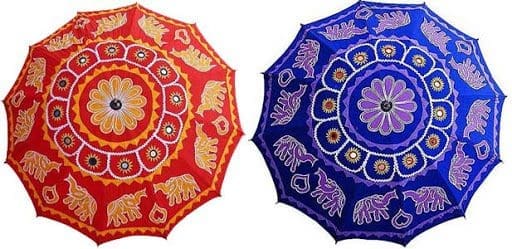
The beautiful craft on dazzling red, purple, black, yellow, green and white fabric evincing some intricate stitches and other very delicate and esoteric embroidery technique is what is known as ‘Applique work’. ‘Applique’, which is a French term, is a technique by which, the decorative effect is obtained by superposing patches of coloured fabrics on a basic fabric, the edges of the patches being sewn in some form of stitchery. It is distinct from what is known as patchwork in, which small pieces of cut fabrics are usually joined side by side to make a large piece of fabric or for repairing a damaged fabric.
While the largest number of appliqué craftsmen are concentrated in Pipli, there are quite a few in Puri and very small numbers in Khallikote, Parlakhemundi and Boudh areas also. A visitor is charmed to see rows of shops in Pipli flaunting applique handbags, cushion covers, bedsheets, pillow covers, canopies, wall hangings, purses and garden umbrellas.
Historical heritage
In the old days the applique craft was patronised by the Kings and other nobility of Orissa, which reached artistic heights of excellence in the first part of the last century. But the origin of the art is traced to the ancient times, although it had become quite popular after the construction of Lord Jagannatha’s Temple in Puri. The roots of the appliqué art & craft form is intertwined with the rituals and traditions of Lord Jagannatha, the presiding deity of the Puri temple.
The Pipli craftsmen supplied canopies, banners, umbrellas and trashas (fans) for festivals of Lord Jagannatha. The Kings of Puri engaged them in the service of Jagannatha. The village Pipli was set up for applique craftsmen. With the pace of time the craftsperson’s started making decorative and utility items when this fascinating work of art reached other parts of India through the pilgrims of Puri.
Basic preparations
Flat motifs are first cut from cloth and specially prepared motifs are made separately. If more than one of the same cut motifs is required, a stencil is used. These cut and specially prepared motifs are then superposed on a base cloth in predetermined layout and sequence.
The edges of the motifs are turned in and skillfully stitched onto the base cloth or stitched by embroidery or without turning as necessary. The specially prepared motifs may be coloured or white. The base cloth is usually coloured. Some of the specially prepared motifs have exclusive embroidery work and some have mirror work. In heavy canopies, a backcloth for strength additionally supports the base cloth.
Producing process
The applique craftsmen first prepare the base material in the shape of square, rectangular and oval pieces. On it the various motifs in the shape of animals, birds, flowers, leaves etc are cut. There is always a perfect Odissi grace in the applique motifs. After the applique patches have been artistically attached to the base cloth and the borders stitched, it becomes a thing of beauty. The stitching process varies from item to item and come under six broad categories, namely, ‘Bakhia‘, ‘Taropa‘, ‘Ganthi‘, ‘Chikana‘, ‘Button-Hole’ and ‘Ruching‘. Sometimes embroidered patterns are also used and in a few items mirror work is also incorporated.
The layout of various motifs and patterns vary according to the shape of the piece. The canopy has a large centrepiece, which may be a square. Several borders of different widths, one outside the other then bound this centrepiece, till the edge is reached.
The motifs used are fairly varied yet fixed and consist of stylised representations of flora and fauna as well as a few mythical figures. Of the more common of these motifs are the elephant, parrot, peacock, ducks, creepers, trees, flowers like lotus, jasmine, half-moon, the Sun and ‘Rahu‘.
Appliqué items are also being used in combination with other handicrafts to produce composite products. An interesting use is the superimposition of appliqué on grass mats and used as partitions. Though earlier the art form was restricted to Darji caste, today it is practised by non-caste members, notably by some young Muslim boys. Unlike many other handicrafts, appliqué items are attractive artifacts of daily use apart from being decorative and they are also comparatively cheaper.

Be the first to comment